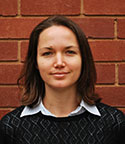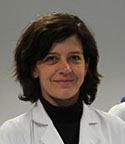Recently, we’ve been profiling first authors of Plant Cell papers that are selected for In Brief summaries. Here are the first-author profiles from the April issue of The Plant Cell.
Kimberley Tilbrook, featured first author of UV-B perception and acclimation in Chlamydomonas reinhardtii
Current Position: OCE Postdoctoral Fellow at CSIRO Agriculture, Black Mountain, ACT, Australia.
Education: BSc (Hons) (2005) and PhD (2011) at The University of Queensland, Australia.
Non-scientific Interests: Sewing, travel, running and surfing.
I was swept into the world of plant biology very early on in my studies, and haven’t looked back since. I’m fascinated by the molecular mechanisms that plants use to make their way in their environments and also inspired by their malleability and application through biotechnology. Following my PhD heavily focused on sugarcane industry biotechnology, I had a desire to go abroad, gain more fundamental research experience and understand the plant on a more holistic level. I was very happy to then join Professor Roman Ulm’s group at the University of Geneva as a post-doctoral researcher working at the forefront of molecular UV-B perception and signaling in the plant cell. During this time, I developed a keen interest in the link between UV-B exposure and acclimation of the photosynthetic apparatus, and enjoyed working with Chlamydomonas so much as to become fond of it. I returned to Australia in 2014 and am currently an OCE Postdoctoral Fellow working again on a plant biotechnology project at CSIRO Agriculture, Black Mountain.
Anja Schneider, featured first author of The evolutionarily conserved protein PHOTOSYNTHESIS AFFECTED MUTANT71 is required for efficient manganese uptake at the thylakoid membrane in Arabidopsis
Current Position: Scientist, Department of Plant Molecular Biology/Botany, Ludwig-Maximilians-Universit ät, Munich, Germany.
Education: PhD: Department of Plant Breeding and Yield Physiology, Max-Planck-Institute for Plant Breeding Research Cologne & University of Cologne, Germany.
Non-scientific Interests: Skiing, swimming and being a mother.
When I was a postdoctoral fellow at the University of Cologne in Prof. Flügge’s group, we studied transport processes across the chloroplast envelope membrane. Using the model organism Arabidopsis thaliana, we analyzed the in vivo function of envelope translocators, which exchange various phosphorylated C3, C5 and C6 compounds for inorganic phosphate. We extended our studies by applying bioinformatics, and it became clear that there are many proteins with unknown function in the chloroplast membrane systems, either at the envelope or at the thylakoid membrane, which could act as transporters. Next, we searched for promising candidates by analyzing the respective Arabidopsis mutant lines and eventually identified pam71 (photosynthesis affected mutant71). Soon, it became clear that pam71 has a specific photosystem II defect and, in Prof. Leister’s group, we performed a thorough mutant analysis. We narrowed down the defect in pam71 to the oxygen-evolving complex, which harbors the inorganic manganese-calcium cluster, and the question arose whether PAM71 is involved in calcium or manganese delivery. Finally, we succeeded and our data support a role for PAM71 as a Mn2+ transporter at the thylakoid membrane. The world of thylakoid membrane transporters is far from being resolved. My future research will focus on these interesting and fascinating proteins.
Łucja Kowalewska, featured first author of Three-dimensional visualization of the internal plastid membrane network during runner bean chloroplast biogenesis. Dynamic model of the tubular-lamellar transformation
Current Position: Post-doctoral scientist in the research group studying the structural and molecular basis of chloroplast function in the Department of Plant Anatomy and Cytology, Faculty of Biology, University of Warsaw, Poland.
Education: Ph.D. (2015) in Biology, Faculty of Biology, University of Warsaw, Poland.
Non-scientific Interests: Performing chamber vocal music, movies, traveling with friends, vinyasa yoga.
When I decided to study biology at the University of Warsaw, I knew that plant biology was what interests me the most. I have always been interested in visual arts, so being a structural plant biologist was a perfect fit for me. My research has focused on different aspects of the dynamic and flexible network of thylakoid membranes. The highly organized structure of the internal plastid membranes and the molecular mechanisms underlying this structure are jointly responsible for photosynthetic efficiency. It is still very fascinating for me how drastically this complicated structure can change in different environmental conditions in a matter of hours to improve the plant condition. Prof. Agnieszka Mostowska has been working on chloroplast development, especially on the structural rearrangements of plastid membranes, since the early 1980s. At that time, only classical TEM microscopy was available, so the fine plastid structure could be studied in two-dimensional cross sections only. The recent development of microscopic techniques, especially electron tomography, enables analysis of the three-dimensional organization of cell structures. Thus, it was possible for me to see detailed spatial structures of plastid membrane arrangements during the transformation from a paracrystalline prolamellar body to the familiar thylakoid network. Additional work by coauthor Radek Mazur, who supplements my structural studies with biochemical and biophysical analysis of the thylakoid network, has made our studies more complete. Although our work is typical basic research, I am convinced that exploring the nature of the thylakoid network and its plasticity will have an impact on the applied aspects of plant biology such as artificial photosynthesis.
